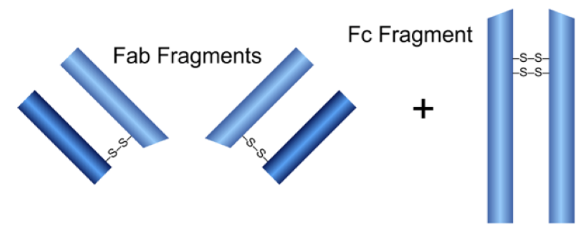Cat. No.
MAK-0002
Product Name
Fab Preparation Kit
Size
10 samples for 250ug-4mg IgG
Storage
4–8°C.
Principle
Immobilized Papain
Description
Mabioway Fab Preparation Kit uses immobilized papain protease to digest human or mouse IgG antibodies to make separate Fab and Fc fragments and subsequently to purify the Fab using Protein A agarose.
Features
• High capacity—use the standard size kit for fragmenting 0.25 to 4 mg IgG.• Enzyme-free digestion products—Immobilized Papain provides for control of the digestion reaction and complete removal of resulting antibody fragments from the proteolytic enzyme• Suitable for human and other species of IgG—the kit procedure is optimized for human, mouse and rabbit IgG. Papain-based digestion is effective for certain other species and subclasses of IgG (e.g., goat and pig), although the purification step requires that the antibody effectively binds to Protein A . (Note: for best results with mouse IgG1, use Part No. MAK-0006.)• Provides ready-to-use Fab—digestion and final recovery of purified Fab fragments occurs in neutral pH sodium phosphate buffer, suitable for storage or immediate use in typical applications• Complete—kits include all reagents needed to prepare and purify antibody fragments• Fast— format greatly reduces sample processing time• Flexible—Protocols are included for multiple species and IgG subclasses, as well as sample size and concentration.• Efficient—enhanced yield and sample purity
Application
These Fab Preparation Kits are suitable for human, rabbit, mouse and other species and subclasses of IgG. The papain antibody digestion reaction is performed in convenient disposable columns that allow efficient removal of the immobilized protease and maximum recovery of the IgG fragments. Also included in the kits are Protein A Columns and buffers to efficiently purify the resulting fragments. Protein A binds the Fc fragments and undigested IgG, allowing the pure Fab fragments to be recovered in the flow-through fraction. The kits also include Desalting Columns for preparing the IgG sample quickly without dilution instead of utilizing time-consuming dialysis steps.The kits use papain, a nonspecific thiol-endopeptidase, to enzymatically cleave whole IgG just above the hinge region to create two separate Fab fragments and one Fc fragment per antibody molecule. Because the papain protease is supplied in immobilized form as beaded agarose resin, the digestion reaction is easily stopped by removing the resin from the IgG solution; the result is digest products that are enzyme-free.
Product Information
• These instructions are optimized for rabbit, human and mouse IgG (250µg-4mg per sample). Fragmentation of IgG from other species might require optimization. For purification, the IgG species must be able to bind to Protein A . For mouse IgG1, use the IgG1 Fab and F(ab´)2 Preparation Kit (Product No. MAK-0006).• The kit components and protocol are for 0.5mL samples containing 0.25-4mg IgG. For 25-250µg samples use the Fab Micro Preparation Kit (Product No. MAK-0001).• Proper sample preparation is essential for successful fragment generation using this kit. If the IgG sample contains a carrier protein such as BSA, use the Antibody Clean-up Kit (Product No. MAK-0007) to remove it before performing the buffer exchange (Section B).
Contents
10 antibody samples, each containing 0.25 to 4 mg IgG• Immobilized Papain Agarose, 1.25 mL• Cysteine-HCl, 0.5g• Fab Digestion Buffer, 100 mL• Protein A Column, 1 mL, 1 column• PBS Packs (each makes 1000 mL), 2 packs• IgG Elution Buffer, 100 mL• Desalt Columns, 7K MWCO, 2mL, 10 columns• Microcentrifuge Tubes, 2 mL, 30 tubes
Additional Materials
• Incubator tube of maintaining 37°C• Microcentrifuge capable of 5000 × g• Variable speed centrifuge• 15mL conical collection tubes• End-over-end mixer or tabletop rocker
Material Preparation
• Digestion Buffer: Dissolve 35mg cysteine•HCl in 10mL of the supplied Fab Digestion Buffer (pH 10). After adding the cysteine•HCl the pH should be ~7.0. Note: Cysteine readily oxidizes to cystine; therefore, prepare this buffer on the same day of use.• Phosphate-buffered Saline (PBS): Dissolve contents of a package in 1000mL of ultrapure water. For long-term storage, add 0.05% sodium azide and store at 4°C.
Procedure
A. Immobilized Papain Equilibration1. Gently swirl the Immobilized Papain vial to obtain an even suspension. 2. Tplace 150μL of the 50% slurry (i.e., 75μL of settled resin) into the 1.5mL Microcentrifuge Tubes at 5000 × g for 1 minute and discard buffer.3. Wash resin with 500μL of Digestion Buffer. Centrifuge column at 5000 × g for 1 minute and discard buffer.B. IgG Sample Preparation1. Desalting Column and loosen cap. Place column in a 2mL collection tube.2. Centrifuge column at 1000 × g for 2 minutes to remove storage solution. Place a mark on the side of the column where the compacted resin is slanted upward. Place column in centrifuge with the mark facing outward in all subsequent centrifugation steps. Note: Resin will appear compacted after centrifugation.3. Add 0.5mL of Digestion Buffer to column. Centrifuge at 1000 × g for 2 minutes to remove buffer. Repeat this step three additional times, discarding buffer from the collection tube.4. Place column in a new collection tube, apply 0.5mL sample to the center of the compacted resin bed.5. replace cap and centrifuge at 1000 × g for 2 minutes to collect the sample. Discard the column after use.6. If IgG sample is 0.5-8mg/mL (i.e., 250µg to 4mg), no further preparation is necessary. If sample volume is less than 0.5mL, add Digestion Buffer to a final volume of 0.5mL.C. Generation of Fragments1. Add 0.5mL of the prepared IgG sample to th tube containing the equilibrated Immobilized Papain. 2. Incubate the digestion reaction for the appropriate time (see Appendix A) with an end-over-end mixer or a tabletop rocker at 37°C. Maintain constant mixing of resin during incubation.3. Centrifuge column at 5000 × g for 1 minute to separate digest from the Immobilized Papain.4. Wash resin with 0.5mL PBS. Centrifuge column at 5000 × g for 1 minute.5. Add the wash fraction to the digested antibody from Step 3. Total sample volume should be 1.0mL. Discard the used Immobilized Papain. Note: To assess digestion completion, evaluate the digest and wash fraction via SDS-PAGE. The separated digest and wash fraction contains cysteine. Boiling samples in non-reducing SDS-PAGE loading buffer will reduce the sample. To avoid reducing the 50kDa Fab fragment on SDS-PAGE, do not boil the samples. See representative gel in Appendix B.D. Fab Purification1. Equilibrate the rotein AColumn, PBS and IgG Elution Buffer to room temperature. Set centrifuge to 1000 × g.2. Place column in a 15mL collection tube and centrifuge for 1 minute to remove storage solution (contains 0.02% sodium azide). Discard the flow-through.3. Equilibrate column by adding 2mL of PBS, centrifuge for 1 minute and discard the flow-through. Repeat this step once.4. Apply sample to column. Resuspend the resin and sample by inversion. Incubate at room temperature with end-over-end mixing for 10 minutes.5. Place column in a new 15mL collection tube and centrifuge for 1 minute. Save the flow-through as this fraction contains Fab fragments.6. For optimal recovery, wash column with 1mL of PBS. Centrifuge for 1 minute and collect the flow-through. Repeat and combine wash fractions with the Fab fraction from Step 5.7. Apply 1mL of IgG Elution Buffer to the Protein A Column and centrifuge for 1 minute. Repeat this step two times to obtain three fractions, which will contain undigested IgG and Fc fragments. To save the undigested IgG or Fc fragments, add 100µL of a neutralization buffer (e.g., 1M phosphate or 1M Tris at pH 8-9) to each of the elution fractions.8. Measure protein concentration by absorbance at 280nm. Use an estimated extinction coefficient of 1.4. Assuming complete IgG digestion, Fab yields may vary from 50 to 65%, depending on the amount of starting antibody and the Protein A ssays used. Protein concentration may also be measured using the BCA Protein A ssay; however, the sample must contain less than 2.5mM cysteine. The undiluted digest and Protein A fraction contains approximately 5mM cysteine. E. Regeneration of the Immobilized Protein A Column1. Add 3mL of IgG Elution Buffer and centrifuge for 1 minute. Repeat and discard flow-through.2. Add 3mL of PBS to the column, centrifuge for 1 minute and discard the flow-through. Repeat three times.3. For storage, add 3mL of 0.02% sodium azide in PBS to column. replace top and bottom caps. Store column upright at 4°C. Columns can be regenerated at least 10 times without significant loss of binding capacity.
Trouble shooting
Problem 1: Low amounts of Fab (50kDa) produced as visualized by nonreducing SDS-PAGE1)The IgG sample was not properly prepared:Dialyze or buffer-exchange IgG into the Digestion Buffer2)Cysteine in the Digestion Buffer oxidized to cystine:Prepare Digestion Buffer with cysteine on the same day of usage3)Sample loading buffer contains reducing reagent:Use SDS loading buffer that does not contain β-mercaptoethanol, DTT or TCEP4)Digested material contains cysteineWash resin with 500µL of Digestion Buffer before adding IgG sample5)Sample contains protein other than IgG (e.g., BSA), which can increase digestion time:Purify the antibody sample with the Antibody Clean-up KitProblem 2: Fab has low immunoreactivity1)Sample was digested for too longReduce digestion time and do not exceed 20 hours or try using the F(ab´)2 Micro Preparation Kit Problem 3: A portion of undigested IgG or Fc does not bind to Protein A 1)Sample is goat IgGTry an alternative purification method such as ionexchange chromatography2)Sample is mouse IgG1Dilute mouse IgG1 sample in Protein A Binding Buffer before adding to the Protein A Column
![]() MAK-0002-Fab Preparation Kit.pdf
MAK-0002-Fab Preparation Kit.pdf



